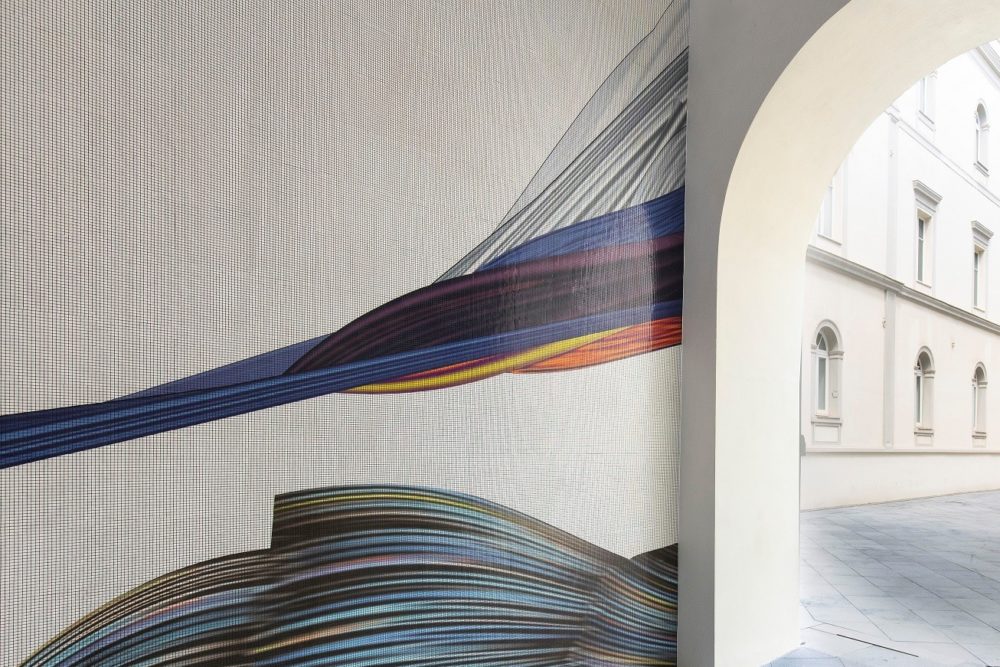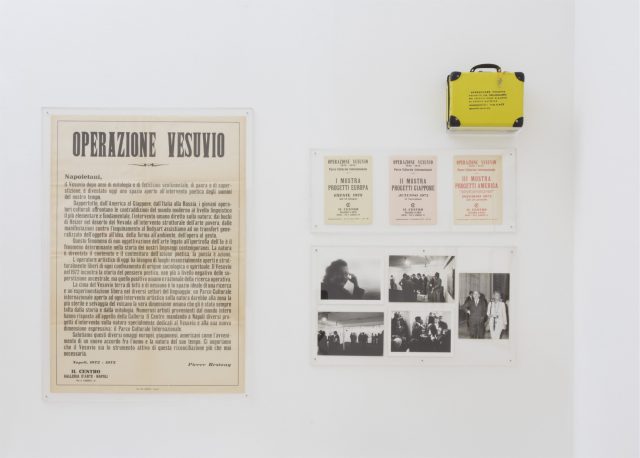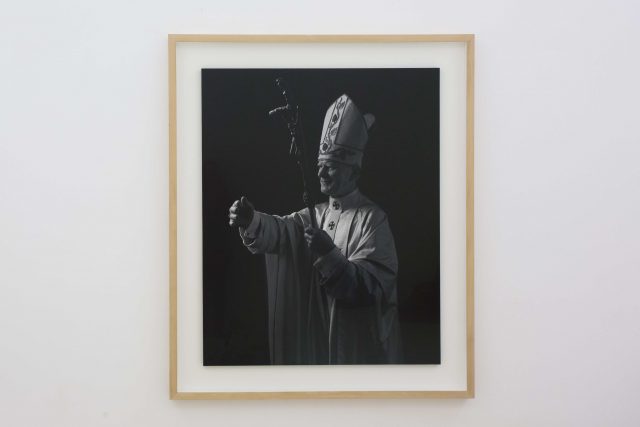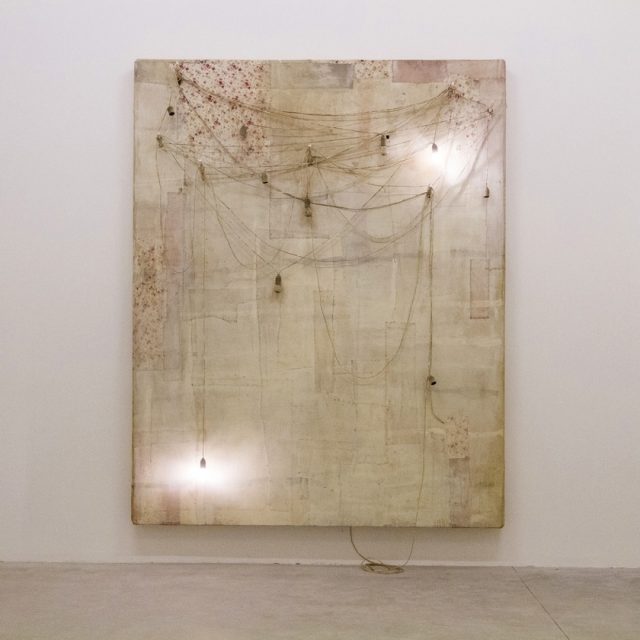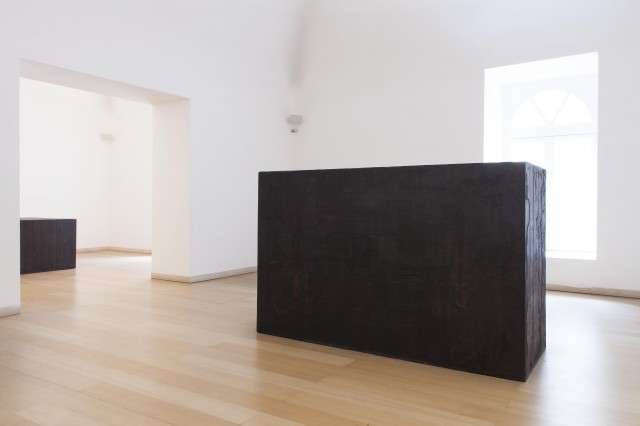After having attended the studio of the artist Carla Accardi in Rome in 1974, and having dedicated himself to the pictorial research, in 1979 Paul Thorel (London, 1956) began to explore the creation of electronic images at the Institut National de l’Audiovisuel in Paris. During the following years he also devoted himself to experimental projects collaborating with TV production centers, IT industries and Universities, and realized projects for cinema, theater and advertising. The accidental distortion of the image and the so-called “snow effect” produced by the meteorological turbulence that, causing the bad reception of the audiovisual signal on the screen, imposed the adjustment of the television antenna, helped to define a mobile and immersive look, an attraction towards the alteration of the image that, at the beginning of the 80’s, led Thorel to be one of the first European artists to explore digital technologies in the photographic practice. At that moment the artist began his work on the digital treatment of the image, and its decomposition into lines, shadows and indistinct features. Since 1982 Thorel has published the results of this research on international photography magazines such as “Aperture”, “Originale”, “Zoom”, “Photographies Magazine” and on several Italian newspapers and magazines.
Starting from a real image, the artist decomposes the recognizable trait in horizontal, lateral and oblique lines, creating a rarefied and indefinite panorama that only a “distant” and visionary look, opposite to the hyper-realism of the photographic medium, can recompose by recognizing in the succession of those that appear as imperfections or vibrating effects of shading, real figures and faces immersed in their context: Portraits, like those presented during personal exhibitions at the Castello Svevo di Bari (2002), the MANN-National Archaeological Museum of Naples (2003) and the Institut Français of Florence (2009). “If you get too close, you can not see.” The distance of the vision, the awesomeness of the gaze, the primitive intuition of the figuration, whether it is a face or a landscape, constitute the vocabulary of this very personal abstraction: those that at first glance seem to be just sequences of decomposed digital features, are instead recomposed in a transversal way making appear something unexpected: the horizon of a subliminal and hypothetical figuration. Perception and intuition, transversality and obliquity, television and information technology movement as opposed to photographic stasis are the fundamental concepts in Thorel’s research. “The oblique look is a look that eludes and that leads you to put yourself to the side of things in order to lose that clarity that would not give space to the chance. Being not too lucid, losing concentration, perceive rather than look, leaving room for the apparitions, these are integral parts of my work tools like the camera and the computer.”
As Greta Travagliati writes, in this sense, Thorel’s research represents a moment of synthesis in “experimentation and consideration on the role of photography in contemporary culture.” The transit from digital decomposition to the real recomposition of the gaze, “the passage” from the absence of vision to intuition are the interpretative elements that in the site-specific installation Passaggio della Vittoria (“Victory Passage”), created specifically for the Madre museum in the context of the project Per_forming a collection. For an art archive in Campania, manifest themselves in their most emblematic meaning, constituting the most accomplished work created to this day by the artist.
The large porcelain and enameled stoneware mosaic obtained by pressing, laid on the four walls of the passage that connects the internal Courtyard of the museum to the Sculpture Courtyard, is inspired by the white mosaic which covers the vault of the Galleria della Vittoria, the 609-meter driveway completed in 1929 connecting the city of Naples from east to west and vice versa, with specular and terminal entrances between Via Acton from Molo Siglio, at the foot of Palazzo Reale and near the neighborhood of San Ferdinando, and in the heart of the Rione della Vittoria, precisely at the historic intersection of Via Chiatamone, Via Giorgio Arcoleo and Via Domenico Morelli. The gallery was one of the first major urban works in terms of size and technological solutions undertaken by the Fascist regime. The artist created, with the support of Mutina for Art, an equally monumental work for the Madre museum: a mosaic of 150 square meters, made with 1,832,400 1×1 cm tiles, decorated with digital machines. A set of shapes, segments, parabolas, horizons and colors, on a white background, that accompanies the visitor from one point to another of his visit. As in the Tapestries series, also in this case the vision starts from hundreds of photographs of sea views, which is a recurring theme in Thorel’s work since the 80’s – joining his beloved Naples, where the artist lives, to the island of Panarea that welcomes him in his moments of rest and reflection.
Thorel reuses the pixel no longer on the screen but on the wall surface through the mosaic, he returns us in a 1×1 cm porcelain tile, the material reality that those small luminous points, beyond the digital image, make up along with millions of other pixels, and what they are able to evoke: the rays of the sun, the reflection of the light on the Neapolitan palaces with their variegated colors, the silver rippling of the blue waters, the iridescent color of the arboreal and floral elements, the magnificence of a gaze that selects, memorizes, recomposes and reconstructs the representation of reality around and within us.
[Silvia Salvati]
